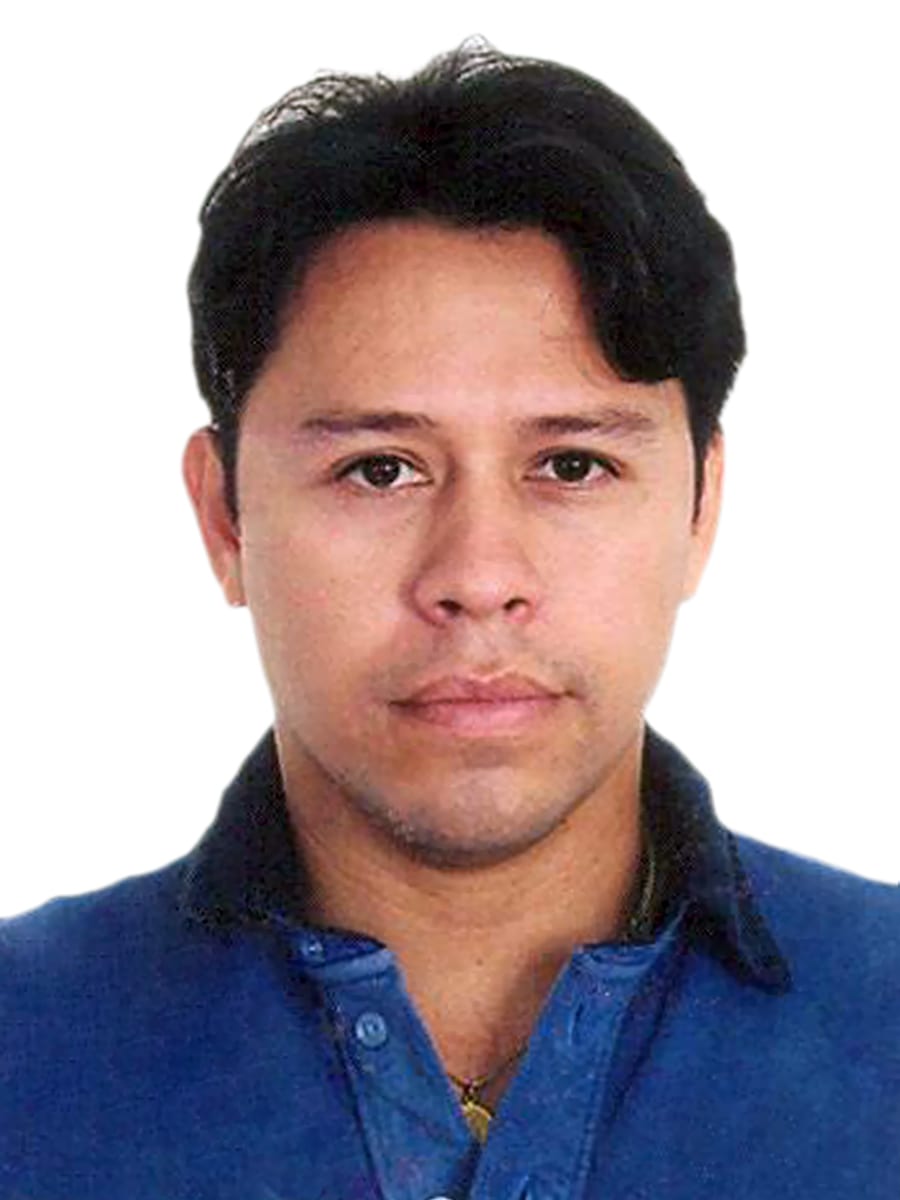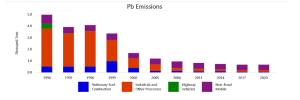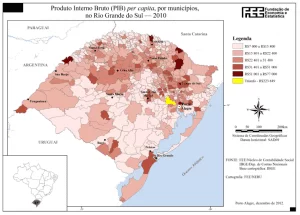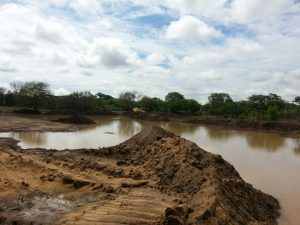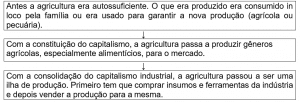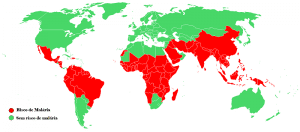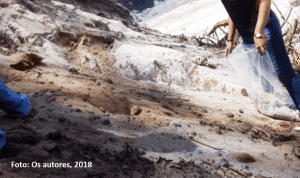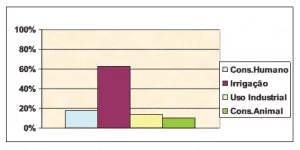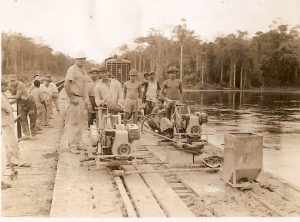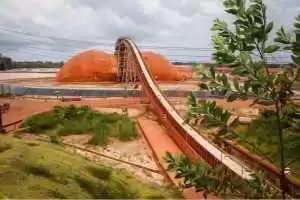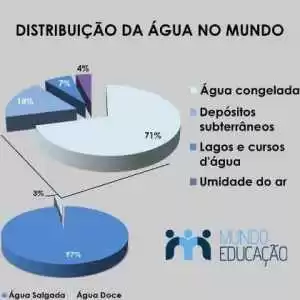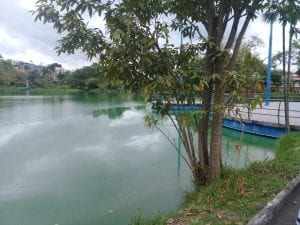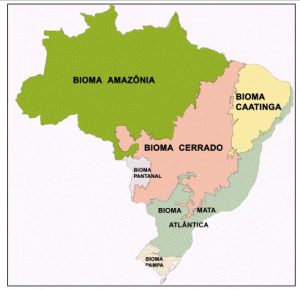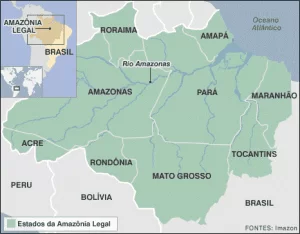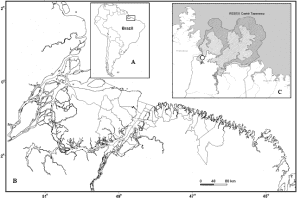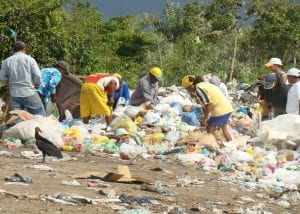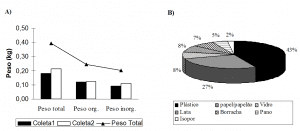QUEIROZ, Kristian Oliveira de [1]
QUEIROZ, Kristian Oliveira de – Creation and Globalization in context: a reading of Tefé in the Amazon – Multidisciplinary Core Scientific knowledge Magazine – Vol. 2. Year. 1. May. 2016, pp. 3-22 – ISSN: 0959-2448
SUMMARY
Analyze the territorial integration of the Middle Solimões region in the Amazon by means of the paper of the centrality of Tefé in the context of a globalisation context is the big goal of this article. First, it presents the history of centrality tefeense. Subsequently, the analysis of the features of Central tefeense under the context of an incomplete modernization in order to understand territorial range of Tefé. Finally, this reading of a territorial integration, i.e. integration relativized, is focused from the acting as agents of globalization in the region of Tefé integrating the current capitalist in this process.
Keywords: territorial Integration, globalization relativized, incomplete modernization, Amazon, Centralities.
INTRODUCTION
The theme of this research came from the desire to know and understand the socio-economic, political and historical features performed by Tefé in the region of the Middle Solimões and Amazonas, training partner brazilian space, directed by capitalist relations in the contemporary world, globalization. The globalization of informational technique impacts with different intensities the places on the globe, subsidised by politics that reaffirms the places and adjusts the local productive adaptation concerns the new territorial settings imposed by hegemonic rationality from the actions of the agents of globalization. These agents bind vertical manner the points that have greater fitness networks that underpin the world economy. In advance of this resistance and this technique rationality which impose values, standards and orders in order to manage the operation of spaces of flows are the places of horizontal solidarity that tend to a disorganization bound by the political pressure and economic and social constraints of the agents of the uprights (SANTOS, 2011,[2000] p. 111).
Some places more absorbing the effects of this globalisation of rationality and technology from its normative and informational, territorial structure previously established. These factors delimit, on its density or rarefaction, the smaller or larger absorption capacity of these effects. However, nowhere is out of reach of the impacts driven by globalization.
Territorial integration takes place in order to admit the repercussions of the economic results of a subspace in relation to other disadvantaged by structural and technical contributions of globalization, modernity vectors that allow radiate intense economic and social influences of subspaces bright through the contributions represented by the actors and actions of contemporary capitalism.
However, front of selectivity imposed by external vectors of globalization, hosted by the technical normative capacity differently and informational, develops a selective modernization and incomplete, making on the process of establishment and performance of the instruments operacionalizam scientific-technical-medium in distant territories of great informational economic centers. Milton Santos (2008[1987]) States that “each man’s worth by where it is: its value as a producer, consumer, citizen depends on their location in the territory” (SANTOS, 2008,[1987] p. 107). Individuals with the same cultural background, sum of capital and physical ability have unequal opportunities effective depending on the position in space in which they are located. This thought gives rise to a reflection about the social and economic situation of citizens in the Amazon.
The Amazon that borders the Solimões River in the State of Amazonas is a region preserved and conserved in relation to States with higher anthropic activity and capitalist. The Amazon has 98% of its territory, and of these, 50.9%, occupied by units of conservation and preservation and indigenous lands by restricting the use of the territory for a variety of purposes such as the cultivation of agricultural products and livestock production (VERÍSSIMO et al., 2011). The Amazon most of Brazilians know is linked to deforestation, the grilagens of land, the Indians and the big jungle far that should be preserved. Many forget that within this “urbanised forest” are organized populations in traditional communities, small towns, medium-sized and even national metropolises. Some at the border and others in exercising their territorial border economic and political roles for centuries.
This is the fraction that is peripheral territorial Tefé, this research study area, far from the decision-making centres of Amazonas State, the country and the world.
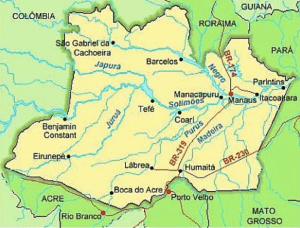
This study provides subsidies to understand that in the Middle Solimões region in the State of Amazonas, the municipality of Tefé is configured as the nodal operation flows established by the movement of goods, commodities and services in the transport and communication network in the Amazonian interior. This research assumes that the means of production more significant for the economy of Tefé relations and streams that comprise its centrality, sometimes made civil servants from the legacy of a fixed concentration of established institutions and infrastructure in the municipality by the appreciation of the strategic position of its territory in the Amazon. Therefore, the circulation is the variable that allows the yeast of life in Tefé. Add to that assumption the hypothesis about the influence of a “globalization context”, typical of opaque, spaces that characterizes and identifies barriers to the territorial integration of Tefé and the region to all brazilian.
Still, it is possible to affirm that this study brings subsidies for the understanding that flows from this centrality tefeense integrate the cities in your area of influence. How does this integration in a subspace where these same streams are limited and, at the same time, fundamental to the economy of the municipality of Tefé and inserted into an incomplete modernization surrounding? In this way, it seeks to provide an understanding of the reasons why Tefé performs the control of space and the management of the territory in the Middle Solimões, which conditioned the functionality of a peripheral centrality, turns out to produce a restricted territorial integration in these times of globalization becomes relativized in several areas. That is, it leads to the assumption that the territorial position of Tefé in the Solimões River is its main economic resource, generating cash flows and limited circulation and consequent of selective globalization incipient developed opaque spaces, where a regionalised capitalism and/or adapted to the means of production available produce different rationales, horizontal lines and same uprights, wrapped in the same globalization process technique , information and standards.
HISTORICAL FORMATION OF CENTRALITY TEFEENSE
The study of regions under the context of an incomplete modernization with unique cultural and physical complexity as the Middle Solimões Amazon amazonense becomes useful and basis for the understanding of poverty entrenched, stagnant economy and a society immersed in “globalitarismos” (SANTOS, 2[2000]011) Latin Americans sell negatively the Amazon region’s true face, this one linked to the wealth of its biodiversity and the inherent cultural richness to the forest people. The low population density of the region hides a people almost forgotten, wrapped a porosity and flow transmutam to them territorial identity already weakened with many ineffective actions arising from public policies linked to socially relevant interests escamoteados the relationship of government-private initiative (IANNI, 1981) that produce the false hope of development in “eternal new frontier” (QUEIROZ, 2013).
Primarily, the greater level of acculturation of the indigenous people who inhabited the place of Ega in relation to other tribes allowed an improvement in the process of commercialization of drugs of the outback. The Portuguese appreciated that, because the Indians knew the finer points of access to the river Solimoes what facilitated the location of forest products, its recoil, the loading and transport of these products for Europeans. Later, the great expeditions that passed through the position of Tefé, mainly from Francisco Orellana and the scribe Carvajal in 1542; and the expedition of Pedro Teixeira and Cristóbal Acuña in 1639. The work of Father Samuel Fritz in the 17th century shaped the Foundation of the first villages in the Solimões, among them Santa Tereza de Tefé, which would be destroyed and rebuilt by Fr. André da Costa some later, the actual instructions 5 and 6 June 1755 founded the village of Ega. The genesis of the tefeense territory. The village is high the city on 15 June 1855. With the appreciation of the strategic position in the Valley of the Amazon, at the mouth of the rio Solimões and Japurá, Tefé, several federal and State public institutions settled in Tefé conditioning to a city that radiates and attracts flows of people, ideas, goods and services in this Amazon region’s subspace.
No function the structure loses its historicity (OLIVEIRA, 1982) which relates to the knowledge of the historic times to the dynamic recognition of all. Over the last four centuries, Tefé accumulated administrative responsibilities, and economic policies. However, material and structural conditions granted by the State were directed to form incipient to contemplate these responsibilities and duties. By the lack of techniques and a huge market, this provoked a restricted development, imposing the Tefé responsibilities that go beyond their ability to manage the territory and fully assume the objectives imposed by territorial and public policies for the development of this region.
PERIPHERAL CENTRALITY
Tefé is considered the largest urban center in the Amazon River upstream of Manaus (IBGE, 2013; Menezes, 2009). Its peripheral position, away from the economic and political center of the country, giving exercise a key role in the movement and in the production of the consumption in this Amazon region’s subspace. The movement of goods, assets and capital inherent in the movement of the centrality and its streams produce a relative economic dynamism from the diversification of traditional features. Occurs in this way, the recovery of Tefé as a urban centre in the region of the Middle Solimões that is configured as the formal expression of the centralization process setting and resetting it through the concentration of equipment, activities, people, ideas and information (AJONAS, 2009).
This results in a better economic situation facing the consumer performance of surrounding cities, bringing economic and social performance of its population which is an attractive consumer market for firms and services within the State. The periphery is understood in this study as the territory that lies far from whence came the national political and social decisions and where economic power is concentrated, the periphery spatial partner.
The periphery is understood in this study as apart of the seats of the corporations and big business, as the place where there is a dilution of the scientific-technical-informational means; understood as the sector that borders the national territory, the edge, close to the border, before her, that by the distance provides the smallest presence and action of the State which turns out to be characterized by poverty, inequality, difference, and the abandonment.
Tefé represents a peripheral centrality when concentrates from the use taxes paid by local people and institutions established in their regional headquarters, collections are important for the maintenance of the streams that allow the movement of capital. The importance of knowledge of the values of these resources arising from transfers of taxes is linked to the role that these State institutions funcionalizam from its services to regional population in Tefé. The influence of Tefé is conditioned to the infrastructure and institutional services that generate a greater appreciation to State municipal levies.
Therefore, institutions become relevant to the economy of the municipality, because its agrarian production is limited. The basis of the rural economy of Tefé is the traditional cassava meal, around 900 tons of this product are produced in the municipality of Tefé (BILLACRÊS and SCHWADE, 2009). In Tefé flour produced in the region is forwarded and packed to its main consumer market in Manaus in large scale. However, apart from this regional productive economy of cassava flour that’s significant to the survival of producers in the region of Tefé, the production of other non-timber and lumber in the countryside could be improved to better meet the municipal economic potential in terms of added value and the accumulation of capital, which would thus constitute as a relevant economic instrument in Tefé.
Imports have not yet been replaced by local production, which become insufficient to feed the city autonomy. Almost everything is imported, much of the food production is from Manaus which provides the goodwill of inputs embedded in the transport and packaging of goods, making the purchase value and making them accessible to the poorest little.
As for livestock, the city has only cut depends on the purchase of cattle, buffaloes and goats in the State of Pará, especially of the lower Amazon cities like Alenquer, Óbidos and Oriximiná. Agriculture, livestock and forestry, are systemic promises of an economy limited by argissolos and plintossolos tefeenses which have limited productivity. In addition to technology and scientific studies can contribute in different ways to address the needs of the population, minimizing and substituting imports and creating productive chains that enable the agricultural autonomy of Tefé and the cities of their influence.
The opaque space economy is characterized by a weakness in the level of trade, insofar as the introduction of modern elements in a “traditional” economy presents its effects and distortions. Tefé, a city that has a key role in the movement of such flows in the Middle Solimões is configured as a limited town and often precarious when providing its services in this polarized, a broadcast model of an incomplete modernization radiating partial development. In this sense, is a centrality which offers relationships with their limited and precarious region reciprocally, a centrality regionally.
THE FEATURES OF THE CENTRALITY OF TEFÉ
In cities with shortcomings and deficiencies in the maintenance of means of production, enabling the survival of their populations the elements that structure the space configure as a means of survival. In this way, it is essential to understand the relevant flows relations institutional activities, concerning the institutions and infrastructure of other agents, as well as trade relations and people are what provide the survival of the city and the region. This makes it possible to understand its centrality and its inherent economic potential make up its subspace.
Institutions, companies, infrastructure and men produce in Tefé life that moves the space, inertia Dynamics (SANTOS (2008, p. 45) [2002]that promotes from fixed points (elements) and drive the streams that will configure the behavior and functions of these elements as a system alive; where the actions and reactions are parts of the whole and This totality, these parties to synchronize. The life that animates the space and the space that promotes life are products of the same strength, unique and crucial. The move raises the centrality from a Center; the flows are coming from. The reading of the means of production of Tefé is linked to the understanding of these institutional, commercial, human movements and the use of infrastructures for the movement of goods, capital, ideas and people.
INSTITUTIONAL CENTRALITY
The discussion of centrality tefeense requires thinking about regional and national dimensions, so the relevance of the reading of this Brazilian subspace involved in distances and dimensions that it is flouting its real capacity to manage.
INSTITUTIONAL ADMINISTRATIVE CENTRALITY
According to Santos (2[1981]008, p. 74) the administrative functions include political function; public and private administration and the military function. Cities with leadership in the underdeveloped world present themselves as crowding institutions and public agencies administrative which attract other functions such as commercial, banking and service functions (table 1).
| Institutions | Territorial Jurisdiction | Employees |
| Army | Tefé, Alvarães, Uarini, Fonte Boa, Japurá, Juruá Maraã, Jutaí,
Santo Antônio do Hoisting, Atalaia do Norte, São Paulo de Olivença, Amaturá, Carauari, Coari, Tocantins, Benjamin Constant |
800 |
| Prelature | Tefé, Alvarães, Uarini, Fonte Boa, Japurá, Juruá Maraã, Jutaí, Carauari, Itamarati | 41 |
| Navy | Tefé, Alvarães, Uarini, Fonte Boa, Japurá, Juruá Maraã, Jutaí, Carauari | 10 |
| PM | Tefé, Alvarães, Uarini, Fonte Boa, Japurá, Juruá Maraã, Jutaí | 191 |
| Irs | Tefé, Alvarães, Uarini, Fonte Boa, Japurá, Juruá Maraã, Jutaí, Eirunepé, Coari, Itamarati, Carauari | 04 |
| Federal Court | Tefé, Alvarães, Uarini, Fonte Boa, Japurá, Juruá Maraã, Jutaí, Tapauá, Carauari. | 31 |
| Federal Prosecutors | Tefé, Alvarães, Uarini, Fonte Boa, Japurá, Juruá Maraã, Jutaí, Coari, Carauari, Tapauá. | 14 |
| Labor courts | Tefé, Alvarães, Uarini, Fonte Boa, Japurá, Juruá Maraã, Jutaí | 09 |
| Registry Constituency | Tefé, Uarini | 03 |
| IBGE | Tefé, Alvarães, Uarini, Fonte Boa, Japurá, Maraã, Jutaí | 03 |
| SESAI/DSEI/COUPLE | Tefé, Alvarães, Uarini, Fonte Boa, Japurá, Juruá Maraã, Jutaí, Itamarati, Envira, Ipixuna, Eirunepé, Coari, Carauari. | 31 |
| FUNAI | Tefé, Alvarães, Uarini, Fonte Boa, Japurá, Maraã. | 04 |
| Icmbio | Tefé, Alvarães, Uarini, Fonte Boa, Japurá, Juruá Maraã, Jutaí, Tocantins, Amaturá, Santo Antônio do Hoisting | 18 |
| INSS | Tefé, Alvarães, Uarini, Fonte Boa, Japurá, Juruá Maraã, Jutaí, Itamarati | 12 |
| DMV | Tefé, Alvarães, Uarini, Fonte Boa, Japurá, Juruá Maraã, Jutaí | 03 |
| Post Office | Tefé, Alvarães, Uarini, Fonte Boa, Japurá, Juruá Maraã, Jutaí | 15 |
| Civilian Police | Tefé, Alvarães, Uarini, Japurá, Maraã | 09 |
| SEFAZ | Tefé, Alvarães, Uarini, Fonte Boa, Japurá, Juruá Maraã, Jutaí | 04 |
Table 1-institutional Centrality in Tefé-2013
Source: Author
CENTRALITY OF INFRASTRUCTURE AND INSTITUTIONAL SERVICES
Santos (2008[2002], p. 67) argues that from the breakdown of infrastructure in the national space and for the choice of those who benefit from a given sector of production and population policy instance ends up deciding the location of enterprises, institutions and men according to specific features. Thus, the location of the infrastructures the territory depends on the political-institutional will in effect. In this sense, Tefé has singularities like its position and the historical conditions favourable to the installation of these relevant infrastructures to the activities of State institutions. His background has allowed the construction of a social and political importance through the human work carried out in the territory used. The product of this human work and even a State planning are infrastructures that allow a city embedded in the world’s largest jungle exercise features regional, national and global. Their infrastructure represented by the airport, the river warehouse, the telecommunications centre, the University and the hospitals offer services not only to the population tefeense, but of all the surrounding cities of Manaus and capital out of the Amazonas State (such as the airport) that require the use of these infrastructures (table 2).
| Institutions | Cities included in the streams | Employees |
| Telecommunications (Hi) | Tefé, Alvarães, Uarini, Fonte Boa, Japurá, Juruá Maraã, Jutaí,
Tonantins, Carauari, Coari, Beruri, Itamarati, Ipixuna, Eirunepé, Envira, Guajará, Codajás, Anori, Anamã, Caapiranga. |
4 |
| Airport (Faa/Fire) | Tefé, Alvarães, Uarini, Fonte Boa, Japurá, Juruá Maraã, Jutaí,
Carauari, São Filipe, São Paulo de Olivença, São Gabriel da Cachoeira, Coari. |
37 |
| River Warehouse | Tefé, Alvarães, Uarini, Fonte Boa, Japurá, Juruá Maraã, Jutaí, Benjamin Constant, Tocantins, Carauari, Tabatinga, Santo Antônio do Hoisting, Coari, Anori, Codajás, Manaus. | 19 |
| Hospitals | Tefé, Alvarães, Uarini, Fonte Boa, Japurá, Juruá Maraã, Jutaí,
Carauari, Tocantins, Coari, Manaus. |
206 |
| Mamirauá | Tefé, Maraã, Manaus, Rio de Janeiro, São Paulo, Pará and Paraná. Countries such as Portugal, United Kingdom, United States, among others. | 242 |
| UEA | Tefé, Alvarães, Uarini, Fonte Boa, Japurá, Juruá Maraã, Jutaí, Benjamin Constant, Tocantins, Tabatinga, Santo Antônio do Hoisting, Apuí, Coari, Tapauá, Itamarati, Caapiranga, Anamã, Manaus. Cities of the States of Rio de Janeiro, São Paulo, Rio Grande do Sul, Paraná, Sant Catarina, Minas Gerais, Pernambuco, Ceará, Pará, Federal District, Alagoas, Roraima, Ceará, Bahia, Spain and Cuba. | 101 |
| Technical Courses
(SENAC, CETAM, private) |
Tefé, Alvarães, Uarini, Fonte Boa, Japurá, Juruá Maraã, Jutaí, Manaus, Rio de Janeiro, Minas Gerais, Goiás and São Paulo. | 50 |
| Banco do Brazil | Tefé, Alvarães, Uarini, Fonte Boa, Japurá, Juruá Maraã, Jutaí | 22 |
| BOX | Tefé, Alvarães, Uarini, Fonte Boa, Japurá, Juruá Maraã, Jutaí | 17 |
| Bradesco | Tefé, Alvarães, Uarini, Japurá, Juruá, Maraã. | 19 |
| Banco da Amazônia | Tefé, Alvarães, Uarini, Fonte Boa, Japurá, Juruá Maraã, Jutaí, Tocantins, Benjamin Constant, Amaturá, São Paulo de Olivença, Santo Antônio do Hoisting, Atalaia do Norte, Tabatinga | 8 |
Table 2 – Institutional Infrastructures of centrality of Tefé
Source: Author
COMMERCIAL CENTRALITY
The space of flows established from the centrality of Tefé activities takes place through the maintenance of State institutions and the monetary circulation of their salary remittances to State tefeense salaried population providing the strength of trade, centrality in the Middle Solimões base. Added to this, the need for the acquisition of goods and merchandise by the populations of the surrounding cities and belonging to his region of influence. A relevant point is the tefeense economy has its production based on the consumption of goods and commodities. A territorial division of labour as well as a division of space consumption is established; the space determined by macrocephaly Manaus, Manaus Industrial Pole (PIM) produces a large part of the national production of durable goods and electronics which exports to the municipalities of the interior of the Amazon that have “access” to these goods and commodities, suscetibiliza territorial fragmentation in this subspace. The Inland cities as Tefé, do not produce products or goods, just consume what they can buy, their production is based on the ability of their populations consume generating movement and economic autonomy. Therefore, the import of food, furniture, equipment, vehicles, fuel, clothing, etc. It is essential for the survival of these cities amazonians. Streams are created from Tefé with luminous cities like Manaus and São Paulo and the established centrality confirms to the globalized capitalist relations that drive life in the Solimões (table 3)
| Companies | Cities included in the streams | Annual drive (Real) |
| Refrigerator Frigopeixe | Tefé, Alvarães, Uarini, Fonte Boa, Japurá, Juruá Maraã, Jutaí,
Carauari, Coari, Manaus, Sao Paulo, Goiânia, Brasília, Belém. |
3.6 million |
| Samana-Beshir Importer and J F Lee Ltda | Tefé, Alvarães, Uarini, Fonte Boa, Japurá, Juruá Maraã, Jutaí. | 5 million |
| Comet Motocenter | Tefé, Alvarães, Uarini, Fonte Boa, Japurá, Juruá Maraã, Jutaí, Carauari, Eirunepé, Envira. | 13.2 million |
| Ceramic industries | Tefé, Alvarães, Uarini, Fonte Boa, Japurá, Juruá Maraã | 2 million |
| Floating Takafaz | Tefé, Alvarães, Uarini, Fonte Boa, Japurá, Juruá Maraã, Jutaí. | 3 million |
| Z4 fishermen colony | Tefé, Alvarães, Uarini, Fonte Boa, Japurá, Juruá Maraã, Parintins, Belém and Manaus. | Not informed |
| Municipal market of Tefé | Tefé, Alvarães, Uarini, Fonte Boa, Japurá, Juruá Maraã, Jutaí, Manaus, Rio de Janeiro, Minas Gerais, Goiás, Rio Grande do Sul and São Paulo. | Not informed |
| Amazonaves | The States of Amazonas, Pará, Rondônia, Roraima, Tocantins, Acre and Amapá. | Not informed |
| Commercial ships and cargo ferries | Tefé, Alvarães, Uarini, Fonte Boa, Japurá, Juruá Maraã, Jutaí, Codajás, Coari, Manaus. | 18 million |
Table 3-Commercial Centrality
Source: Author
CENTRALITY OF POPULATION
The centrality of population develops through encounter and contact with people from different backgrounds in a place, streams that provide a community based organization in the interests of a collective that produces the foundations of a social organization built an experience developed through these relationships and exchanges between people. In the case of Tefé this organization constituted historically, motivated primarily by economic interests linked to the exploitation of drugs of the hinterland and, mainly, to the institutional constraints linked to the strategic position in the Western Amazon, factors that operate as centripetal forces creating a synergy in place.
The features of demographic intertwine centrality to other previously analyzed in this study (institutional and commercial centres); However, has elements that provide a dynamic linked to regional circulation. It should be noted that the network node represented by Tefé in the region if contextualizes geographical objects established and activated by movement, as well as by the energy from the demographic movement originated by the basic needs of men present in this place.
The human centrality in Tefé is also negative flows, mainly linked to urbanisation and social consequences of exclusion and violence this process generates. As regional urban centre Tefé has problems with excess vehicles and traffic problems, noise pollution relevant (QUEIROZ, 2009) and urban violence from mainly the trafficking and use of drugs. The military police and the army are the major agents in an attempt to mitigate the problems caused by trafficking and drug use in Tefé, where is the base of operations of these two institutions for the whole region.
The peripheral population presents its centrality, their habits, their customs, their traditions, their human relationships that are still genuine representatives of a subspace, even incipient traces of hegemonic world society.
BANKING INTEGRATION
Territorial integration relativized established by economic and social dynamics of an incomplete modernization and primordial elements of subsidised globalization represented by the finance and services (SASSEN, 1998) composing distinct forms of this globalisation process.
In the Middle Solimões, and particularly in Tefé, shows that globalization relativized establish functionality of networks, communicating the global actions to locations, and by the action of the State, economic development officer and technical and social modernization, allowing the financial performance of the territory and the movement of capital of the collective work from State employees.
The finance and structured by the technical services and information, under “tv action” allow a global action and a social and economic modernization, tend to perform their activities in a limited way in subspaces in a globalization context, where the elements of infrastructure, technology, skilled personnel and capital available is incipient. This scenario causes losses to the economy and territorial integration deficiencies, hindering the full access of this subspace once chaired by Tefé to scientific-technical-informational medium that as Saints (1999) “is the face of globalization”. It is assumed that are relevant to streams of deficiencies centrality of Tefé, seen as an intermediate city in this subspace opaque, which enables an integration relativized, by rubbing the territorial division of the previous work with the territorial division of the current work. That is, there is a poor integration into the process of globalization that involves and impacts the world differently.
The centrality in the periphery becomes a centrality to central places, however integrated, relative.
It discusses at the moment the loss of centrality force effected by Tefé in your region facing the advancement of globalization, by the action of objects perfect technical comprising uprights joined by “tele” and information and communication technology available to small towns or regional any region that provide connectivity to the world. The result is a territorial integration that ignores its own territorial boundaries, cultural identities and traditions.
Banking integration aims to discuss the nuances of the various derived forms of a same process, globalization, in their approaches and foundations that fragment and compartmentalize territories and if you play as a process of the production of space. Banking integration is based on communication and the relationship of cities obsolete with the bright cities taking place via the subjugation of urban and territorial traditional hierarchies, creating breaks with “city-links” in the historical dynamics of regional development and territorial organization of training partner.
It should be noted that the integration relativized is configured as a territorial integration under conditions of incomplete modernization and globalization context. It is assumed that the agents of this integration process to promote both the course of globalization as to the geographical environment, the technical-scientific-informational medium.
The integration of opaque to globalisation spaces is based on the contradiction inherent in the current capitalist mode of production, which does not allow fully develop the productive potential of places.
The biggest agent of these finances in Tefé and in your region are banks and draining financial incomes of employees, retirees and employees of trade through its services for the headquarters of these banks. Work collecting these rents in partnership with several commercial companies as well as airlines, ground vehicles and inland waterway; offering services such as private pension funds, real estate credit, maternity aid, credit and loans that are sought after by customers of banks. The existing financial agents in Tefé that allow this chair the relationships in this fraction of the territory are significant in the face of its hinterland. This centralisation of capital is due to fixed infrastructures inherited during the historical and economic context provided by the dynamism of its centrality in this subspace lethargic.
In Tefé financial owners prioritize the location of your accommodation in the vicinity of banks and even close to other financials, offer credits and payments of Bank slips, which decentralizes the Bank flows as well as the lottery and the postal Bank. In this same street tefeense, there are firms that propose the query on the credit protection service (SPC) and SERASA for aid in the reconditioning of the credit if you are negative, if there is a problem in the loan request, creative agents of financial activity.
This situation exposes the institutional centrality of Tefé in this Amazon region’s subspace shows two forms of urban relationships analogous to dynamics of cities. The centrality in shaping brazilian space partner peripheral represented by Tefé exposes its external relations in order to valorise the territory in its strategic position on the territorial edge and keep the presence of important services to the State in this subspace far from major centers. This scenario provides the cities as Tefé exercise, more intense, the links and activities with distant centers and still keep its territorial management and who owns the adjacent past urban hierarchies as the basis of their relations.
The city of Carauari is institutionally with Tefé despite being under the influence of Manaus as well as other southern cities of the Amazon as Eirunepé, Itamarati and Lábrea located outside of the area of influence of Tefé and using the services of INSS in Tefé. This is observed in the flows and territorial jurisdictions of other institutions such as the IRS and the Federal Court.
The economic and social life of the population entered in the cities of tefeense hinterland has been influenced by these cities to access foreign markets via urban relations based on information and technology, influenced and modernizing commercial and financial operations. Inserting new forms of performing jobs tied to new requirements imposed by modernity that articulates via the perfect objects and technical features of the scientific-technical-informational medium.
The presence of the righteous flows from air transport operations and modern River operating in Tefé region; commercial enterprises with export purposes using the natural resources available in the municipalities; the services of professionals and especially those that are connected to the internet and the IRS, not obey full organizational prerogative and consistent policy that may converge to the guidelines and rules of the global economy which allowed the free action of capital and of the actions of agents of globalization “more lax” (SANTOS, 2001).
Carauari and Coari present themselves as vertical points in exogenous orders force the places via the power of obedience capital providing the outbreak of other fighting and disagreements between these external and internal forces. Develops like this, “a dialectic between the heterogeneity of the territory and the homogeneizadora trend of the market resulting in a spatial hierarchy” (SEN, 1999, p. 166). The low capacity to manage objects and strange techniques to the site provides a low organizational and administrative control; with minimums functions the city is managed by agents and contextualized by a modernisation “feitichizada” vulnerable to the activities of the operators that tend to override the places to explore. This happens when the resources are exhausted or their capital if you value to allow the acquisition of new clusters of oil exploration elsewhere in the world. Carauari showed that only the flows that built the infrastructure and who promoted the speculation still non-existent production promoted a surge of growth and relative development, an integration relativized. The power of capital shown when well managed agile in its political and social circumstances, flows from a globalization context characterized by low density technique and capitalist rationality inherent miniature peripherals provide vertical solidarity subspaces front the dynamics of engineering systems that direct the functioning of technical objects useful to the production. The contributions of globalization are part of the global system territories by blocking a horizontal solidarity, i.e. a contiguous cooperation of the economic and social results.
Sassen (1998, p. 72) States that “those cities that are strategic locations in the global economy tend to disconnect from your region”, in other words, these tax systems and economic models in cities don’t promote territorial integration. The analysis of this author is based on the absolute globalization of bright spaces, global cities that communicate from the agents of globalization operating in this scenario.
However, in the scenario of a globalization context, the assertion of this author also performs the relativized integration if directs from cities that Act funcionalizando a vertical solidarity, benefiting places and distant agents to the site, producing and shredders Bible humpers relations to regional development. Thus, shredder streams are desarticuladores of productive sectors between cities with meager savings as the Middle Solimões and belonging to the tefeense hinterland. In this way, are negligenciadores of a resurgence of the economy and righteous flows that bring the yeast of integration and equality.
CONCLUSION
Discuss the territorial integration of the Middle Solimões region from a reading of Tefé in the Amazon was the purpose of this article. The analysis of the centrality of dynamic spatial elements by operationalized that create streams and integrate the tefeense hinterland towns to a globalization context enabled the understanding of the role of Tefé as a link in a given integration to technical-scientific-informational medium.
The genesis and setting the centrality of Tefé in the Middle Solimões resulted from a long historical period marked by the presence of several agents, missionaries, explorers, travelers, scientists and indigenous people. These agents contributed to the movement of goods, people, ideas and information is structured according to the position of Tefé in communication and transportation network to become a center of attraction and distribution of flows that make up a relevant in the Amazon region’s centrality.
The processes pertaining to appreciation of the tefeense territory were of global, national and local spheres; different scales involved since the assignments of the demarcation of boundaries of the Treaty of Madrid and Santo Idelfonso until the political actions that intensified a dynamic linked to national and regional interests, many of which have undergone the territory to a fragmentation. Contradictions were directed, because many of these municipalities created lacked sufficient structures to generate their economic autonomy, including Tefé, the municipality originates, if submitting the joint action of the kind of regional production available who promoted the “autonomy” of the cities of the Middle Solimões. This kind of production is mainly on movement linked to wages and salaries for civil servants, as the collection of drugs of the hinterland and other features do not bring any significant benefit to the economic autonomy of municipalities over their stories.
It was evidenced that the streams that make up the centrality tefeense configure itself as the means of production more relevant to the economy and the city’s autonomy. A particularity of the place, linked to its dynamic role in the circulation in the transport and communication network of the Middle Solimões, has been set up, acting as a commercial trunking and exercising a bias to the cities adapted to survive with the scarce, with the distant, to the limited and precarious. It is concluded that the features of the centrality of Tefé to configure how a service center, trade and institutional assistance to the populations of this Amazon region’s subspace.
Tefeenses if link flows to streams from worldwide agents that enter the region via the constraints of contemporary capitalism, globalization. External standards and orders prompted and organized by these agents holding a hegemonic rationality, linked to the speed and the use of perfect objects that run mainly finance and contemporary services, funcionalizam sectors operated by instruments of scientific-technical-informational medium.
Tefé, the largest urban centre of a subspace lethargic, is a town undergoing a modernization. The global production and marketing standards impose a remodel of your administrative and functional role as network node of the Middle Solimões. Validated the idea that Tefé accumulates the functions of regional and city confluindo intermediate times and territorial divisions of the separate work space chambered aiming to functionalize the orders and regulations that provide the valorization of the territory that enables the establishment of normed vector stakeholders the economic dynamics of the urban ones in your area.
It follows that the towns of Tefé region are configured as places of “sparse times”, in which the relevant vectors to the technical-scientific-informational medium and hegemonic rationality inherent in globalization are present in smaller proportions.
Territorial integration takes place with the repercussions of economic activities of a subspace in another; in the region of the Middle Solimões Amazon these repercussions are like flashes of bright spaces that reflect in these dark spaces. In this sense, the contemporary geographical environment build a incomplete modernization radiate serving a limited capacity to enter into space, due to the condition of the Amazonian distances, logistics costs and infrastructural insecurity which provides limited performances linked to features of their spatial elements. This promotes disabled streams, which create obstacles to their primordial objectives, because they are limited, incontínuos and therefore “incomplete streams”.
It is concluded that Tefé acts in such a way as to integrate respect, assuming a regional city and skills of an intermediate city in spatial instances, because it absorbs ambiguous due to deficient performance skills of its network of transport and communications. Aspects of a given integration that performs under the conditions of insecurity and operational failure of its objects and streams, that is, a dynamic social and economic subject to limitations imposed by an incomplete modernization.
It was evidenced that a limited territorial integration restricted to the process of globalisation and to the technical-scientific-informational medium is made possible by Tefé to cities that comprise its hinterland in the Middle Solimões.
The analysis of the centrality of Tefé and peripheral integration relativized provided the basis for understanding that there is a change in the strength and direction of the flows of this centrality, influenced by modern shortcuts “tele action” that allow the actors of globalisation if enter in any consumer market in the world and so on its share of production technique. Validated the idea of a weakening of centrality and functions formerly performed by Tefé due to other cities access to finance and services inherent in globalization. The relationships of these cities could intensify with the capital Manaus and other urban centers. Due to accessibility to services and communications networks exerting a paradoxical role, would also serve as obstacles for being funcionalizadas, in large part, of techniques and curios and slow promoting of incomplete manner the relationships that should be quick and beneficial to the interests of distant agents eager to expand their capital.
Argued that the territorial integration relativized established by economic and social dynamics of an incomplete modernization and primordial elements of subsidised globalization represented by the finance and services. These agents analyzed pertain to technical-scientific-informational medium because they were founded as production hubs and nodes movement of energy, air transport and telecommunications in real time. Configure as insertion of this Amazon region’s subspace agents, via the operacionalidades undertaken to the geographical environment and the current capitalism, integrating it into the process of globalization.
It can be concluded that Tefé, headquarters of relevant institutions to telecommunications services and transport, despite losing the strength of their centrality, easing the streams that once presided over, continues to exert a feature as central management of the territory. This provides those who are using their institutional services and health, educational infrastructures, air transportation, financial institutions, and policies related to civil society a shelter facing the scarcity of these agents in cities in his region of influence and within the State.
It is therefore concluded that the geographical position of Tefé, 525 km from Manaus, i.e. outside of the metropolitan area of the capital and in the periphery macrocéfala manauara, supports for his dynamic role through their administrative and institutional capabilities. As well as the use of their infrastructure that enable you to exercise and preside over the territorial management linked to the activities inherent in a network node in the Solimoes. An advanced Center of territorial management in the Amazon border.
In the light of the geographical science perspectives is expected to have contributed to the understanding of this territorial fraction that has the largest urban centre Tefé, sometimes forgotten and for many not even known. But, that performs a major role in the management of the territory, in maintaining sovereignty in the Amazon border and in the recognition of a regional identity among the various existing in “Amazons” was built by traditions, customs and values inherited from the meeting of Indians, blacks and whites that inhabit the Valley of the “great river of the Amazons” in ancient and imposing the Solimões River.
REFERENCES
AJONAS, Andréia de Cássia da Silva. Center and centrality in Itu. Master thesis-graduate program in geography of Universidade Estadual Paulista “Júlio Mesquita Filho”, Faculty of science and technology, Presidente Prudente, 2009.
BILLACRÊS, Maximum Afonso Rodrigues; SCHWADE, James Muller Maiká. Clusters in the Solimões River. XIX National Agrarian Geography-ENGA. Annals. São Paulo, 2009.
IANNI, Octavian. The struggle for the land: social history and the struggle for land in the Amazon area. Petrópolis: Vozes, 1981.
IBGE. Atlas of the 2010 Census. Coordination of geography. Rio de Janeiro: IBGE, 2013.
Menezes, Maria Lucia Pires. Cities and control modes of space and territory in the Western brazilian Amazon. In: ARÁGON, Louis E.; OLIVEIRA, José Aldemir de. Amazon in the South American setting. Manaus: Editora da Universidade Federal do Amazonas, 2009.
Ariovaldo Umbelino de Oliveira. Space and time, dialectical materialist understanding. In: SANTOS, Milton. New directions of brazilian geography. São Paulo: Hucitec, 1982.
Queiroz, Kristian OLA. Noise pollution caused at critical points in the municipality of Tefé. Porto Alegre: Editora, 2009.
Queiroz, Kristian OLA. The “eternal new frontier” and the shortcomings of the Amazon region’s power grid. X national meeting of the National Association of graduate studies and research in geography. Annals. Campinas: UNIVERSIDADE ESTADUAL DE CAMPINAS, Oct. 2013.
SASSEN, Saskia. The cities in the world economy. Translation: Carlos Eugenio Marcondes de Moura. São Paulo: Studio Nobel, 1998.
SANTOS, Milton. Space saving: criticism and alternatives. Translation: Maria Irene k. Szmrecsányi, 2nd Ed. São Paulo: Editora da Universidade de São Paulo, 2011[1979].
SANTOS, Milton. The technical and scientific production and spatial differentiation. Turf Magazine. Year IV, n° 6, jan/jun, 1999.
SANTOS, Milton. Globalization. São Paulo, Rede Record. Program moving to clean/Rede Record, 2001. Discussion of the book “For another globalization” of Prof. Dr. Milton Santos. Interview by Boris Casoy.
SANTOS, Milton. For another globalization-the single thought to the universal consciousness. Rio de Janeiro: Record, 2011 (2000).
SANTOS, Milton. Handbook of urban geography. 3rd Ed. São Paulo: Editora da Universidade de São Paulo, 2008[1981].
SANTOS, Milton. Citizen space. 7th Ed. São Paulo: Editora da Universidade de São Paulo, 2008[1987].
SILVEIRA, Maria Laura. A country, a region: end of the century and modernity in Argentina. São Paulo: FAPESP/LABOPLAN-USP, 1999.
VERISSIMO, Adalberto et al (eds). Protected areas in brazilian Amazonia: progress and challenges. Bethlehem: Imazon; São Paulo: Instituto Socioambiental, 2011.
[1] PhD in geography. Universidade do Estado do Amazonas.
